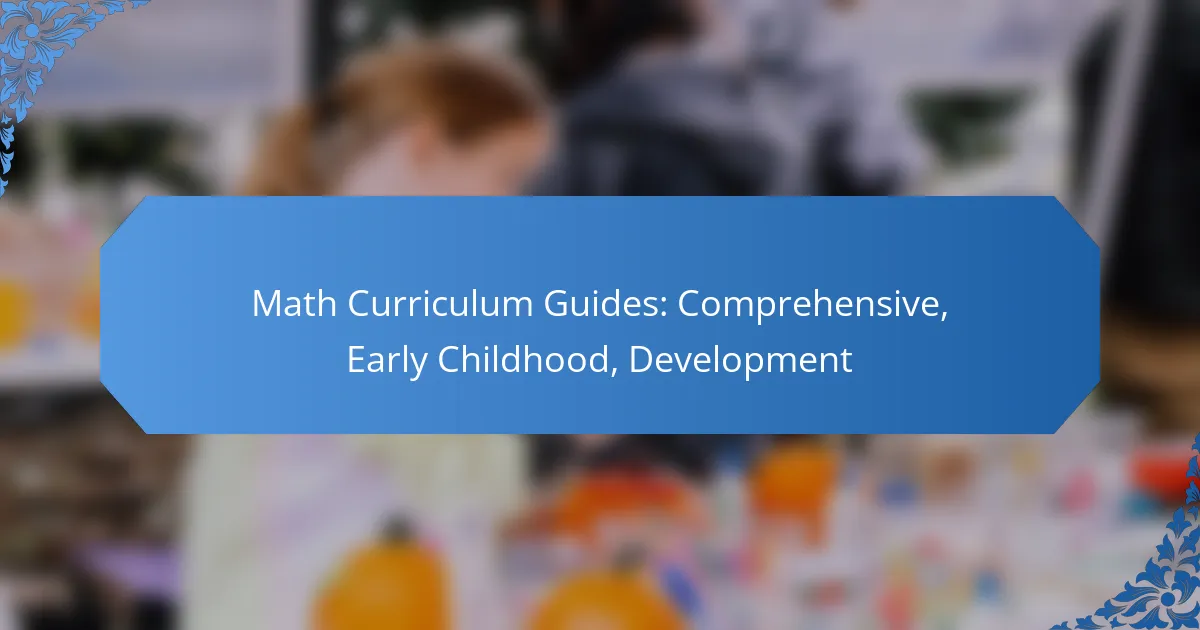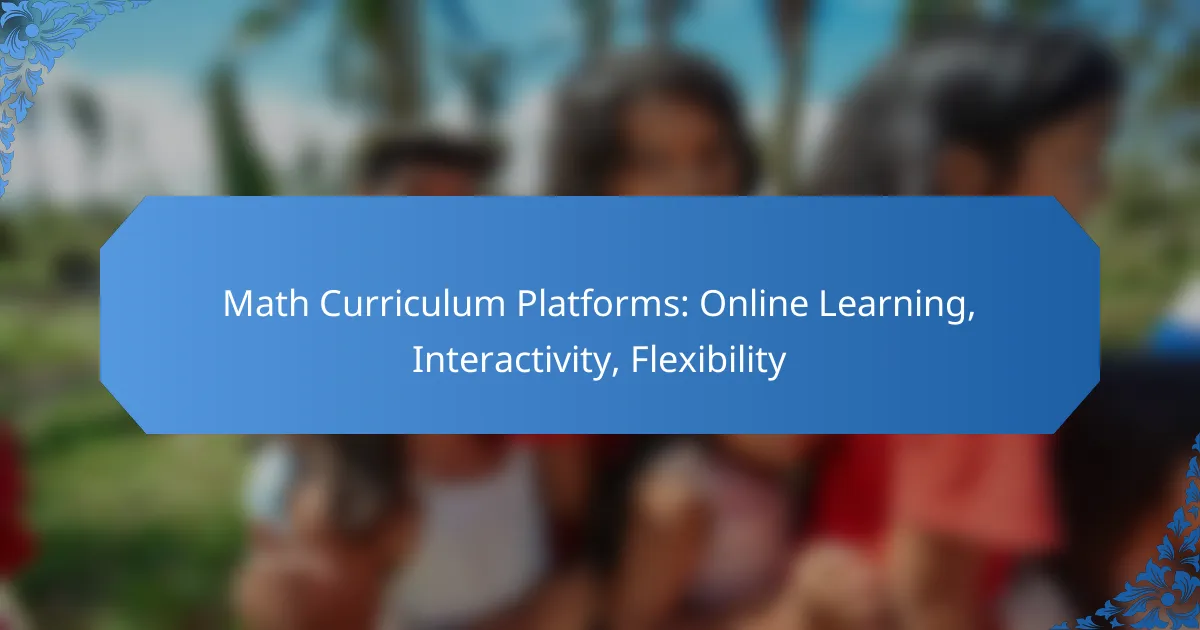Math curriculum guides for early childhood are essential tools that provide structured frameworks to help young learners build foundational math skills. By emphasizing hands-on experiences and play-based learning, these guides align with educational standards to create a positive learning environment. They also outline key components such as learning objectives and assessment strategies, ensuring effective instruction and consistent skill development for students.
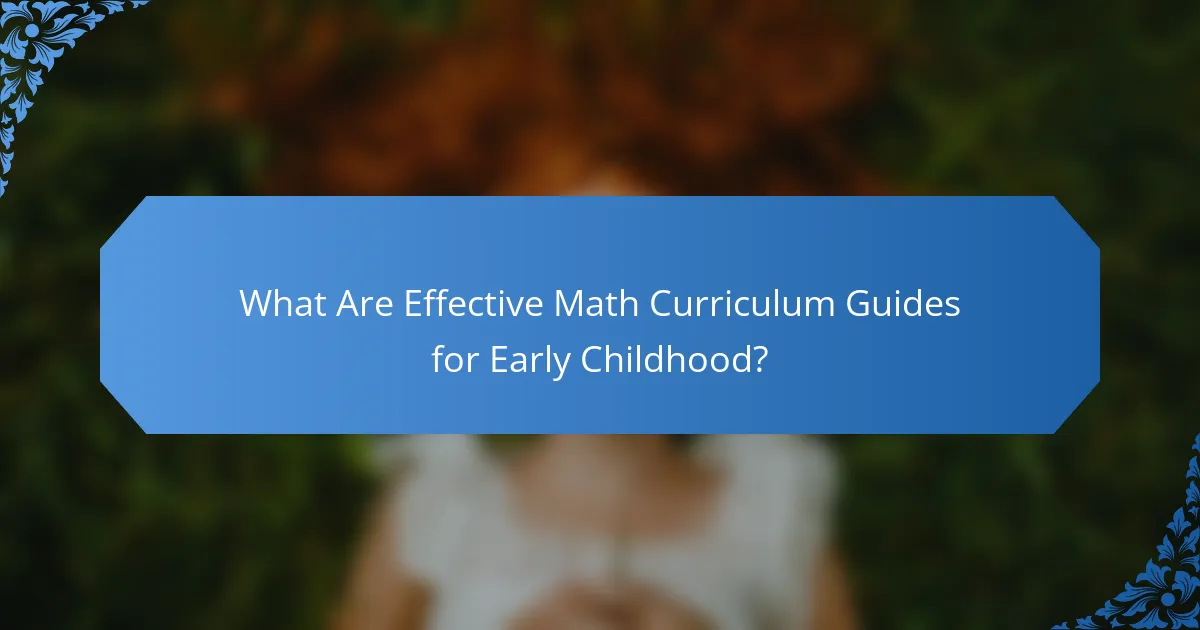
What Are Effective Math Curriculum Guides for Early Childhood?
Effective math curriculum guides for early childhood provide structured frameworks that support young learners in developing foundational math skills. These guides emphasize hands-on experiences, play-based learning, and alignment with educational standards to foster a positive attitude towards mathematics.
HighScope Curriculum
The HighScope Curriculum focuses on active participatory learning, where children engage in hands-on activities that promote problem-solving and critical thinking. It incorporates a daily routine that includes planning, doing, and reviewing, allowing children to reflect on their learning experiences.
In math, HighScope encourages exploration through activities like counting objects, measuring ingredients for cooking, and sorting shapes. Educators are trained to observe and assess children’s progress, adapting activities to meet individual needs.
Montessori Method
The Montessori Method emphasizes self-directed learning, allowing children to choose activities that interest them. This approach fosters independence and encourages exploration of mathematical concepts through tactile materials, such as counting beads and geometric shapes.
In a Montessori classroom, math is integrated into daily life, with activities that promote practical skills like measuring and budgeting. The method supports mixed-age classrooms, enabling older children to mentor younger peers, enhancing collaborative learning.
Creative Curriculum
The Creative Curriculum is designed to be comprehensive and flexible, focusing on the whole child and integrating various domains of learning, including math. It uses thematic units that connect math concepts to real-world situations, making learning relevant and engaging.
Activities might include counting items during a grocery store role-play or measuring ingredients for a class recipe. Teachers are encouraged to create a rich learning environment that promotes exploration and inquiry in mathematics.
Common Core Standards
The Common Core Standards provide a clear set of expectations for what children should learn in math at each grade level. These standards emphasize critical thinking, problem-solving, and the application of math skills in real-world contexts.
For early childhood, the standards focus on foundational skills such as counting, number recognition, and basic operations. Educators should align their curriculum with these standards to ensure that children are prepared for future academic success.
Head Start Framework
The Head Start Framework is designed to support the development of children from low-income families, emphasizing school readiness. It includes specific goals for math skills, such as recognizing numbers and understanding basic concepts of measurement and patterns.
Programs following this framework often incorporate family engagement and community resources to enhance learning. Activities are designed to be culturally relevant and responsive, ensuring that all children have equitable access to quality math education.
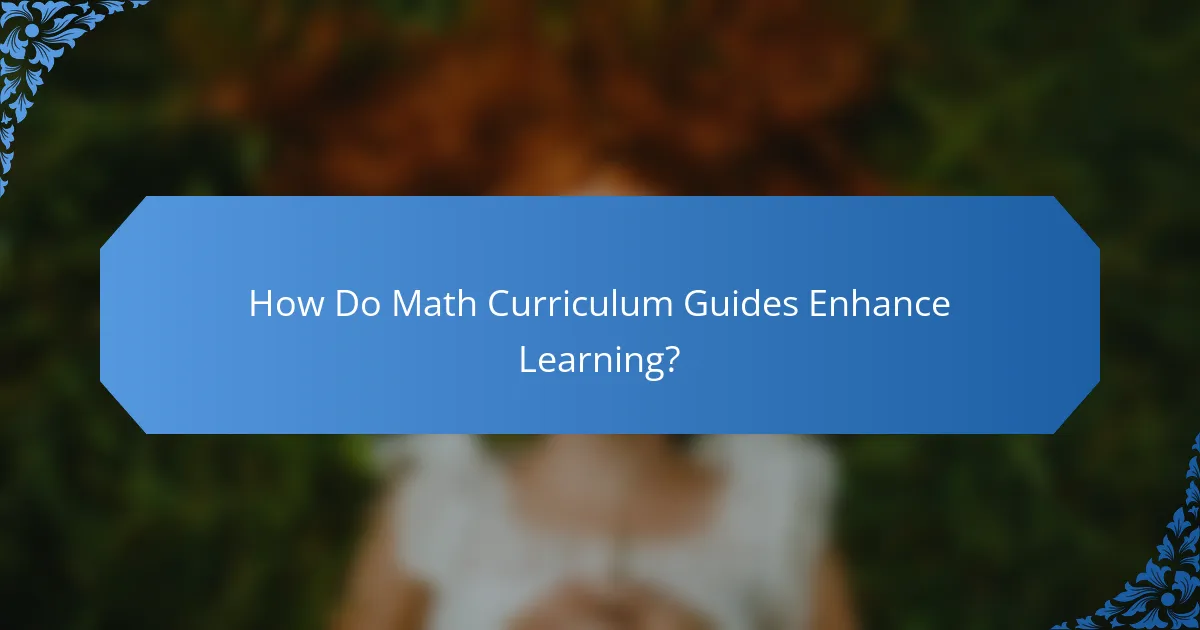
How Do Math Curriculum Guides Enhance Learning?
Math curriculum guides enhance learning by providing structured frameworks that outline educational goals, content, and assessment methods. These guides help educators deliver consistent and effective instruction, ensuring that students develop essential mathematical skills and concepts.
Promote Critical Thinking
Math curriculum guides promote critical thinking by encouraging students to analyze problems and evaluate solutions. By integrating real-world scenarios and open-ended questions, these guides challenge learners to think beyond rote memorization and apply their knowledge in various contexts.
For example, a curriculum might include projects that require students to design a budget for a community event, prompting them to consider costs, resources, and outcomes. This approach not only enhances critical thinking but also makes math relevant and engaging.
Encourage Problem-Solving Skills
These guides encourage problem-solving skills by presenting students with diverse mathematical challenges that require strategic thinking. Through a variety of exercises, students learn to approach problems methodically, breaking them down into manageable parts.
In practice, a curriculum may introduce puzzles or games that require students to use logic and reasoning to find solutions. This hands-on experience fosters resilience and adaptability, essential traits for tackling complex problems in everyday life.
Support Individual Learning Styles
Math curriculum guides support individual learning styles by offering multiple pathways for understanding mathematical concepts. Recognizing that students learn differently, these guides often include visual aids, manipulatives, and interactive activities to cater to various preferences.
For instance, a curriculum might provide options for students to explore geometry through drawing, building models, or using digital tools. This flexibility allows each learner to engage with the material in a way that resonates with them, enhancing overall comprehension and retention.

What Are the Key Components of a Math Curriculum Guide?
A math curriculum guide outlines essential elements that ensure effective teaching and learning of mathematics. Key components include learning objectives, assessment strategies, instructional materials, and teacher training resources, all tailored to meet educational standards and student needs.
Learning Objectives
Learning objectives define what students should know and be able to do at each stage of their mathematical education. These objectives should be specific, measurable, and aligned with national or state standards, such as the Common Core State Standards in the United States.
For early childhood education, objectives might focus on basic number recognition, counting skills, and understanding simple shapes. As students progress, objectives can expand to include problem-solving skills and the ability to apply mathematical concepts in real-world situations.
Assessment Strategies
Assessment strategies are crucial for measuring student understanding and progress in mathematics. These can include formative assessments, such as quizzes and class activities, as well as summative assessments like standardized tests.
Effective assessments should provide immediate feedback to both students and teachers. For example, using performance tasks that require students to demonstrate their problem-solving process can offer deeper insights into their mathematical thinking.
Instructional Materials
Instructional materials encompass the resources used to teach mathematics, including textbooks, manipulatives, and digital tools. High-quality materials should be engaging and relevant, catering to diverse learning styles and abilities.
In early childhood settings, materials like counting blocks or interactive math games can enhance learning. For older students, incorporating technology, such as math software or online resources, can support independent learning and practice.
Teacher Training Resources
Teacher training resources are essential for equipping educators with the skills and knowledge to effectively deliver the math curriculum. Professional development opportunities can include workshops, online courses, and collaborative planning sessions.
Training should focus on best practices in math instruction, including strategies for differentiating instruction and integrating technology into lessons. Ongoing support and mentorship can help teachers refine their skills and adapt to changing educational standards.

How to Choose the Right Math Curriculum for Early Childhood?
Choosing the right math curriculum for early childhood involves evaluating how well it meets educational standards, its flexibility, and its cost. A suitable curriculum should engage young learners while providing a solid foundation in mathematical concepts.
Alignment with Educational Standards
Ensure the math curriculum aligns with national or state educational standards, such as the Common Core State Standards in the U.S. This alignment guarantees that the curriculum covers essential skills and concepts appropriate for early learners.
Look for programs that explicitly state their alignment with these standards, as this can help in assessing the curriculum’s effectiveness. For example, a curriculum that emphasizes counting, number recognition, and basic operations will typically meet early childhood benchmarks.
Flexibility and Adaptability
The best math curricula are flexible and can adapt to various learning environments, whether in a classroom or at home. Consider programs that offer a range of instructional methods, such as hands-on activities, digital resources, and printable worksheets.
Additionally, check if the curriculum allows for differentiation to cater to diverse learning styles and paces. For instance, some children may benefit from visual aids, while others might excel with auditory instructions.
Cost and Resource Availability
Evaluate the cost of the math curriculum and the resources required for implementation. Some programs may have a one-time purchase fee, while others might require ongoing subscriptions or additional materials.
Consider your budget and the availability of resources in your area. Free or low-cost options, such as community resources or online platforms, can supplement more expensive curricula. Always check for any hidden costs, such as shipping or additional materials needed for effective teaching.

What Are the Benefits of Online Math Courses for Early Childhood Educators?
Online math courses offer early childhood educators flexible, accessible, and effective professional development opportunities. These courses enhance teaching skills, provide innovative strategies, and foster a deeper understanding of early math concepts.
Accessible Professional Development
Online math courses provide early childhood educators with the ability to learn at their own pace and convenience. This flexibility allows educators to balance their professional development with their teaching responsibilities and personal commitments.
Many online platforms offer courses that are aligned with national and local early childhood education standards, making it easier for educators to find relevant content. Additionally, these courses often feature a variety of formats, including videos, quizzes, and interactive modules, catering to different learning styles.
Interactive Learning Experiences
Online math courses frequently incorporate interactive elements that engage educators and enhance their learning experience. Features such as simulations, virtual manipulatives, and collaborative projects allow educators to practice new strategies in a supportive environment.
For example, an online course might include a module where educators can experiment with digital tools to teach counting or basic addition. This hands-on approach not only reinforces learning but also equips educators with practical skills they can implement in their classrooms.
Networking Opportunities
Participating in online math courses allows early childhood educators to connect with peers from various regions and backgrounds. This networking can lead to valuable exchanges of ideas, resources, and best practices that enhance teaching methods.
Many online courses include discussion forums or social media groups where educators can share experiences and seek advice. Building a professional network through these platforms can provide ongoing support and inspiration long after the course has ended.
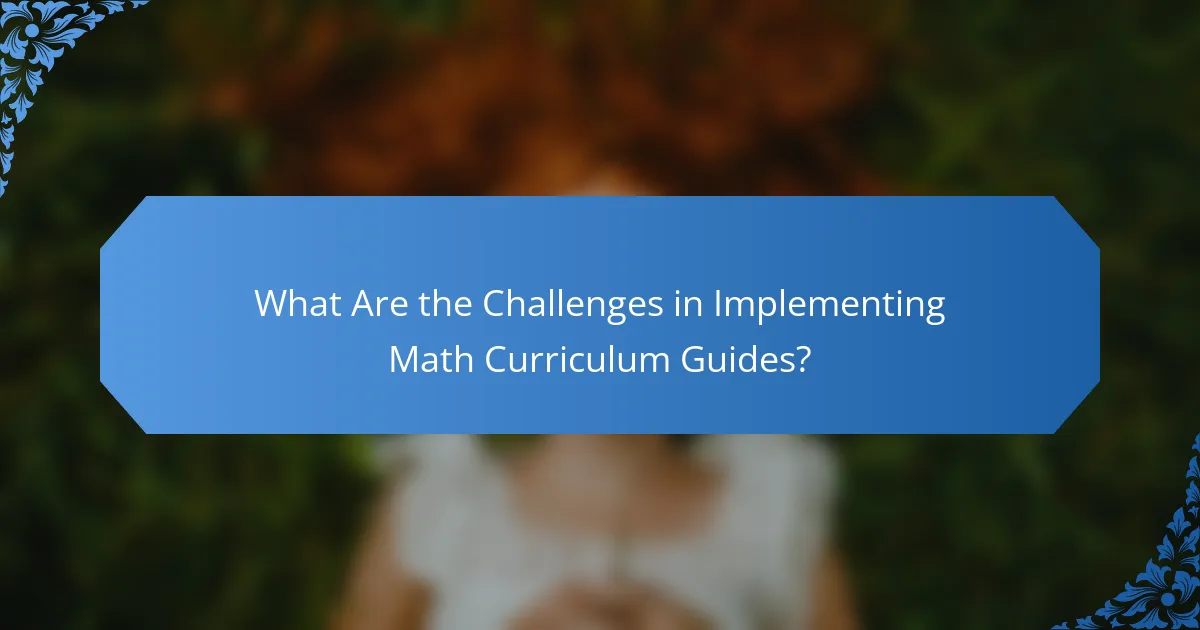
What Are the Challenges in Implementing Math Curriculum Guides?
Implementing math curriculum guides can be challenging due to factors such as varying student needs, resource limitations, and the need for teacher training. These challenges can hinder effective delivery and adaptation of the curriculum to meet educational standards.
Understanding Diverse Learning Needs
Students come with different backgrounds, learning styles, and paces, which can complicate the implementation of a standardized math curriculum. Educators must assess individual needs and adapt lessons accordingly, ensuring that all students can grasp mathematical concepts effectively.
For example, some students may excel with visual aids while others benefit from hands-on activities. Teachers should consider incorporating a variety of teaching methods to cater to these diverse learning preferences.
Resource Availability and Allocation
Limited resources, including textbooks, technology, and teaching materials, can pose significant hurdles in implementing math curriculum guides. Schools may need to prioritize spending and seek additional funding or partnerships to enhance their math programs.
For instance, utilizing free online resources or community partnerships can help supplement materials. Schools should regularly evaluate their resource allocation to ensure they are effectively supporting math instruction.
Teacher Training and Professional Development
Effective implementation of math curriculum guides requires ongoing teacher training and professional development. Educators must be familiar with the curriculum content and instructional strategies to engage students effectively.
Providing regular workshops and collaborative planning sessions can help teachers share best practices and address challenges. Schools should encourage a culture of continuous learning to enhance teaching effectiveness in mathematics.
